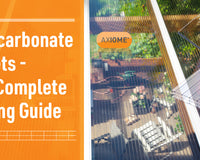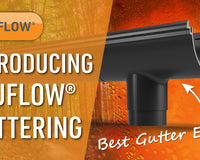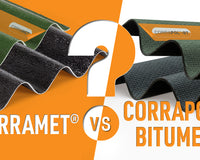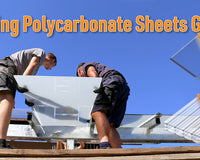6 Types of Roof Lantern - You Can Make Yourself For Less
There’s nothing like daylight flooding in to a room through a Roof Lantern to make the room feel large and airy. Whether it’s a burst of brightness from sunrise, or the colourful glow of a sunset, and right throughout the day in between, Roof Lanterns bring living spaces to life. Flat Roof Skylights, Non-Opening Pitched Roof Windows, and Pitched Roof Skylights come in many designs, and whilst all of them give the same great daylight effect, Roof Lanterns can add value to your property with increased architectural presence and prestige looks.
If you are looking for the maximum daylight from your Roof Lantern but not looking to spend too much, then you should definitely consider the types of Roof Lights you can make yourself, which we set out in this article on the 6 Different Types of Roof Lantern, below. The lowest cost Skylights or Roof Lanterns are made from Roof Glazing Bars, and are really easy to make and install, especially if you are a Trade user and used to general joinery or roofing projects. Below we compare these six types of Roof Lantern, all of which will provide excellent daylight effects and more than likely add appeal to your property.
You’ve probably got a few additional questions on Roof Lanterns, so we have set out the 10 Most Common Roof Lantern Questions below and have gone through each one to explain a lot of the key points, however if you have additional questions, we’d love to hear from you, so please comment in the box at the bottom of this page and we’ll come back to you with our answers.
OK, let’s get stuck in to this… There are two sections below as follows:
What 6 Types of Roof Lantern Can I Make?
- Single Slope Roof Lantern Flat Roof
- Single Slope Roof Light Inset on Tiled Roof
- Apex Roof Lantern for Flat Roof with Victorian Ends
- Apex Roof Lantern for Flat Roof with Gable Ends
- Apex Inline Roof Lantern for Pitched Roof
- Apex Inline Roof Lantern for Pitched Roof with Gable End
The 10 Most Common Roof Lantern Questions Answered:
- What is a Roof Lantern?
- Are Roof Lanterns a Good Idea?
- What is the Best Roof Lantern?
- Does a Roof Lantern Need Planning Permission?
- Are Roof Lanterns Cold?
- Are Roof Lanterns Noisy In the rain?
- How do I make my own Roof Lantern?
- Does a Roof Lantern Add Value to Property?
- Can you Put a Roof Lantern on Pitched Roof?
- Can you use Polycarbonate Sheets for a Roof Lantern?
What 6 Types of Roof Lantern Can I Make?
Let’s go through the differences between each of the 6 main Roof Lanterns which are easy enough for Trade and DIY alike to create and install:
1. Single Slope Roof Lantern Flat Roof
Over the past 20 years, with the introduction of high-quality flat roof membranes such as EPDM and PVC, flat roofing has evolved from the traditional felt type of roof that is fraught with problems of leaking, in to truly long-term flat roof opportunities which are reckoned to last for 30 - 50 years. Now with an ever-increasing popularity of flat roof constructions and architectural design it’s easy to add a bespoke roof lantern, opening up many excellent design opportunities of Roof Lanterns Combinations.
For a more modern contemporary designs a Single Slope Roof Lantern is essentially built over a square or rectangular hole (or void) created in the middle of a flat roof, which has an upstand (or frame) created around it, which has one side raised up higher than the other. With one side of this frame created higher than the other around the hole (void) in the roof, this provides a natural single slope on it. The sides of the upstand are insulated and waterproofed, and then you can rest Aluminium Glazing Bars across the void, and finally glaze the Roof Lantern with Glass Units or Polycarbonate Sheets.

Extra Info: What Glazing Bars are Best for Roof Lanterns?
- Rafter Top Glazing Bars for Timber Rafters: For these you simply create your own timber rafters to span across the Roof Lantern and fix the glass down with the Aluminium Screw Down Glazing Bars. You will reduce costs typically by a further 50% if you glaze the Roof Lantern with Polycarbonate Sheets, which also give you the option then to use Snap Down Glazing Bars for Rafters, however the aluminium glazing bars typically have an extra 95% additional life expectancy, so are preferred for longer term projects where the focus is longevity.
- Self-Supporting Aluminium Glazing Bars: If you choose Self-Support Aluminium Glazing Bars, they are fully maintenance-free, fast to install, and save the extra work otherwise required to create the Timber Rafters. When choosing Self-Support Aluminium Glazing Bars, it’s a good idea to make sure they are Aluminium Glazing Bars which are suitable for Glass of any thickness, so that the Glazing Bars suit 6mm Laminated Glass, right up to 28mm glass units or thicker.
Explainer: What is a Single Slope Roof Lantern?
Single slope, simply means sloping only one way, as opposed to an Apex Roof Lantern which has a slope in two directions meeting at a centre ridge.
2. Single Slope Roof Light Inset on Tiled Roof
Pitched Roofs are normally finished with a layer of waterproof felt or breathable roof membrane, and then covered with Slates or Tiles. Where you require a non-opening Roof Light in a room, you can simply remove a section of the tiles and cut a hole between two rafters to create an excellent Pitched Roof Light. These roof lights allow some excellent creativity and architecturally impressive results with options to leave exposed timber joists for example. The powerful effect of the natural daylight beaming in through these Roof Lights in any room, makes it feel larger, more comfortable and airier, as well as reducing energy costs otherwise needed to light the room.
Pitched Roof Lights are easy to create using glass and glazing bars. Unlike opening roof windows, you can create some incredible designs of bespoke non-opening rooflights to suit whatever style and age of Property you are working on. Typically, a bespoke roof lights made from glass units and glazing bars can cost you 45% less than buying in readymade opening roof windows.

Pro Tips: 10 Simple Steps to Making a Non-Opening Pitched Roof Window:
- Remove slates or tiles on the roof area, slightly larger than the chosen window opening
- Carefully cut away felt and roof boards (sarking) in between where you are making the opening
- Create a 100mm (4”) high timber upstand around the Roof Window area
- Dress the timber upstand with lead, PVC or similar waterproof flashing
- Overlap the lead over the original roof felt at the lower end of the slope
- Slip the lead under the original roof felt at the upper end of the slope
- Replace Roof Tiles around the dressed Timber Upstand
- Add Timber Rafters, or Self-Supporting Glazing Bars from top to bottom of the Roof Window
- Place the glass or polycarbonate sheet on to the Timber Rafters or Self-Supporting Glazing Bars
- Finally, simply screw down the Rafter Top Glazing Bars (Use Rafter Top Gable Bars for the sides and an Endstop Bar for top and Bottom edges) ensuring you fix the Glazing Bar end caps securely to assist avoiding any glazing slippage.
These Illustrations below help to demonstrate the above 10 Simple Steps for pitched Non-Opening Roof Windows:
Rafter Top Aluminium Screw Down Glazing Bar System:

Self Support Aluminium Screw Down Glazing Bar System:

3. Apex Roof Lantern for Flat Roof with Victorian Ends
When you are making a Roof Lantern on a Flat roof, it’s a great idea to consider the options of different styles which may be best suited to the particular type of property the Roof Lantern project is for. As an alternative option to a Single Slope Roof Lantern, if the property is an older style, it may be more suited to an Apex Roof Lantern style. An Apex Roof Lantern is a Roof Lantern that has two slopes meeting at a centre ridge point.
An Apex Roof Lantern with Victorian Ends is where the Ridge is shorter than the length of the overall Roof Lantern opening and there are angles bars at each end of the Ridge sloping down to each corner creating stylish triangular segments of glazing at each end. The detail on the Ridge end connection for an Apex Roof Lantern with Victorian Ends is more complex and will require a reasonable degree of skill to ensure it is totally waterproof.

Apex Roof Lanterns look amazing when the rafters are made from a hardwood, so the underside looks like an ornate timber structure, but then using Aluminium Rafter Top Glazing Bars for the outside, for a maintenance-free long-lasting, waterproof finish. Apex Roof Lanterns tend to have smaller ridges than Conservatories, so you can reduce costs by using a Rafter Top Hip Bar for the Ridge glazing, which connects to a Roof Lantern Radius Endcap for each end.
4. Apex Roof Lantern for Flat Roof with Gable Ends
For a mid-range style, the Apex Roof Lantern with Gable Ends is a great option. The two-sided Roof Lantern has a Ridge the full length of the Roof Lantern, meaning that each end comes to a vertical Apex end which can either be solid or made a feature of as a vertical window section.
This Gable Ended Roof Lantern style can be also made from hardwood for that semi-traditional style, again using the Rafter Top Hip Bar for the Ridge glazing which will reduce costs greatly. You can also consider using Polycarbonate Sheets for the glazing which would save typically 20% on your overall cost.
Choosing to create vertical Gable Ends on an Apex Roof Lantern makes sealing the ends of the Ridge Top Hip Bar super simple for waterproofing and a professional and aesthetically pleasing finish.

5. Apex Inline Roof Lantern for Pitched Roof
Where you have a vaulted apex internal ceiling which follows the angle of the Roof Joists it gives great height inside the room. A vaulted ceiling internally is often found in first floor rooms to maximise the height of these upstairs rooms, but Vaulted Ceilings are also now common on first floor buildings and extensions to give maximum height and architectural presence to the room and a feeling of ambience and enlarged space.
Extra Info: What is a Vaulted Roof?
A Vaulted roof is where instead of having a flat ceiling across creating a loft, the rafters are insulated directly below and plaster-boarded so that the internal ceiling has a slope following the roof rafters to the ridge creating an Apex, or inverted ‘V’ shape ceiling inside which provides extra height and a great feeling of space.
Where you have a vaulted ceiling, you can go to the extra step and easily create an Apex Inline Roof Lantern for a pitched roof, which will brighten up the room and make a huge feeling of extra space streaming with natural light! Furthermore, it is relatively inexpensive and easy to create using glass units or Polycarbonate Sheets which can be glazed on to the rafters fixed with Aluminium Rafter Top Glazing Bars. These glazing bars are super-easy to install and come with screws, bar gaskets, rafter gaskets and glazing endcaps.
An Apex Inline Roof Lantern for a pitched roof is highly likely to increase the look and feel of a room and the Property as a whole potentially increasing the desirability and value of the real estate.

-
Wooden Glazing Bars – (Not advisable) - We don’t recommend using wood for exterior glazing due to its limited longevity
6. Apex Inline Roof Lantern for Pitched Roof with Gable End
In the point above we have discussed an Apex Inline Roof Lantern for a pitched roof, which is a one of the most impressive types of rooflight, adding style and finesse with natural daylight to any room with a vaulted ceiling. However, where a room with a vaulted ceiling has an external gable wall, you can create an even more impressive style of Inline Roof Lantern, by creating the vertical gable wall with an Apex Window at the top of the wall, and then continuing the Apex Inline Roof Lantern to the end of the roof.
Building an Apex Inline Roof Lantern for Pitched Roof with Gable End provides an incredible skyline view and heaps of natural daylight for the room, saving energy and making the room feel large and airy. The external and internal appearance of these Roof Lanterns enhances the desirability of the property, and more than likely increases the overall property value and saleability.
Bonus Tip: What is an Overhanging Apex Inline Roof Lantern?
For the ultimate in Skylights or Roof Lantern prestige consider the Overhanging Apex Inline Roof Lantern which is the same as an Apex Inline Roof Lantern for Pitched Roof with Gable End, however the Gable Wall of the Property is set back, say two to three metres, and the Apex Roof and Valuated Ceiling overhang by the same distance. This creates an amazing canopy that creates a brightness and natural light feeling, as well as giving additional skyline views. When the Overhanging Apex Inline Roof Lantern is created on a first floor (or higher) it creates a superb covered balcony canopy area for the ultimate outdoor-indoor lifestyle combinations.

For all the above Roof Lantern and Roof Light options you can use either Aluminium Self-Supporting Glazing Bars or Aluminium Rafter Top Glazing Bars that screw down in to Timber Rafters or Timber Joists. You can also choose from a range of options on the glazing itself, from twinwall polycarbonate sheets, single laminated glass and gas filled glass units, depending on the type of Roof Lantern, type of Property and your budget range.
The 10 Most Common Roof Lantern Questions Answered:
Set out below, are the 10 Most common questions about Roof Lanterns, which provide some additional information to give a wide understanding of Roof Lanterns and their many applications:
- What is a Roof Lantern?
- Are Roof Lanterns a Good Idea?
- What is the Best Roof Lantern?
- Does a Roof Lantern Need Planning Permission?
- Are Roof Lanterns Cold?
- Are Roof Lanterns Noisy In the rain?
- How do I make my own Roof Lantern?
- Does a Roof Lantern Add Value to Property?
- Can you Put a Roof Lantern on Pitched Roof?
- Can you use Polycarbonate Sheets for a Roof Lantern?
1. What is a Roof Lantern?
A Roof Lantern is a secondary structure on top of another main roof which is generally raised and has a transparent glass or polycarbonate glazed roof to allow natural light through the main (or primary) roof and in to the building below. Roof Lanterns create a feeling of brightness, space and enhanced ambience. Roof Lanterns are architecturally and aesthetically pleasing and can add value and desirability to a property.
Extra Info: What is a Skylight?
Extra Info: What is a Roof Window?
2. Are Roof Lanterns a Good Idea?
Roof Lanterns are a good idea for nearly any building design, because they offer not only immediate benefits for the property occupants but also long-term benefits. We have set out 8 Reasons below why Roof Lanterns are a good idea and a great benefit:
8 Reasons why Roof Lanterns are a good idea:
- The inside living experience is greatly improved with Roof Lanterns
- Roof Lanterns Increase Presence and Desirability of a Property
- Naturalight from Roof Lanterns creates a Bright Airy feeling
- Property Values are enhanced with Roof Lanterns
- Extra Daylight from Roof Lanterns can Reduce the Effects of Winter Depression
- Bespoke Roof Lanterns Create Architectural Features to Properties
- Enhanced Ambience from Roof Lanterns makes for Better Use of Rooms
- Using Natural Light Roof Lanterns reduce the Need for Lights, saving Energy
3. What is the best roof Lantern?
The Best Roof Lantern depends on the application and area of use of the Roof Lantern. For example, if you have a flat roof with a modern looking Property then a Single Slope Roof Lantern is the best option, whereas if you have a Pitched Roof with an older traditionally looking property with vaulted ceilings then the best Roof Lantern would be an Inline Apex Roof Lantern, as described earlier in this article above. For an Inline Apex Roof Lantern, you could also make it look really historic by adding some Crests along the top of the Ridge and a Finial at the end of the Ridge for style. Bespoke Roof Lanterns can be made in so many designs, you can really unleash your creative flare and design some amazing Roof Lanterns that will have a powerful visual effect.
4. Do Roof Lanterns Need Planning Permission?
It is unlikely that you will require planning permission for a Roof Lantern installation as long as you follow your local and regional planning regulations. Very often a Roof Lantern can’t actually be seen from neighbouring properties due to eyesight lines and the heights of the roof, however if in doubt it’s a good idea to contact your local planning department to verify this for your area.
Even in the rarer situations when planning permission is required because Roof Lanterns are an excellent benefit to properties in saving energy, improve occupants’ lifestyles and are aesthetically pleasing it should be very easy to obtain any required permission.
5. Are Roof Lanterns Cold?
Using gas filled glass sealed units or multiwall polycarbonate sheets on Roof Lanterns improves insulation, meaning that Roof Lanterns are not cold. Furthermore, with the greenhouse effect, the sunlight coming through can mean that the Roof Lanterns are a net contributor to the heating of the building and keep it warm. Depending on the location of the Roof Lantern and direction the slope of the Roof Lantern is facing, Roof Lanterns can contribute to the heating of the Rooms and livings spaces below them.
6. Are Roof Lanterns Noisy In the rain?
Rain falling on Roof Lanterns will make some noise just like rain does when rain is blown against a window on a windy and rainy day, however it is not overly noisy. Many people actually choose Roof Lanterns for the very reason that they seek the natural effect and gentle sound of rain falling on a Roof Lantern as a modern inside-outside balance of life and natural living experience, complimenting the ambient light effects that Roof Lanterns provide.
7. How do I make my own roof Lantern?
One of the great things about Roof Lanterns is that they are relatively simple to create. In the article above we have shared 10 Simple Steps to Making a Non-Opening Pitched Roof Window, along with an illustration of how you install a Roof Lantern. If you are needing extra help, it may be a good idea to contact a local glazier to help you with the roof glazing parts once you have completed the joinery steps.
8. Does a Roof Lantern Add Value to Property?
Whilst there is no fixed tangible proof of this, it’s a well-accepted fact that Roof Lanterns can add architectural presence and desirability to a property externally. Also Roof Lanterns give a feeling of increased space and airiness internally, often making a room or building seem much larger that it is, which in turn also makes it a far more pleasant ambient space. On balance there is a strong correlation between desirability and demand for Properties with these enhances features such as Roof Lanterns, which inherently increases the value of the Property.
9. Can you Put a roof Lantern on Pitched Roof?
Yes, you can put a Roof Lantern on Pitched (Sloped) Roof and in fact some of the finest architectural results are achieved by creating Roof Lanterns this way. Earlier in this article we discuss two types of Apex Roof Lanterns which you can create that produce stunning results.
10. Can you use Polycarbonate Sheets for a Roof Lantern?
Polycarbonate Sheets are proven to provide a reliable long-lasting glazing sheet, and can be used for a Roof Lantern. For Roof Lanterns where insulation is required then Multiwall Polycarbonate Sheets with a UV Protection work well. The advantage of Polycarbonate Roofing Sheets in glazing Roof Lanterns is that onsite size adjustments are easy to make compared to glass units which cannot be changed.
Would you like further advice Roof Lanterns?
We hope you found this article useful. Our Teams are always happy to help with additional advice via our Live Chat or you can email shop@clearamber.com where our super friendly Teams will provide you with all the advice and support you require for your projects.
Alternatively, leave a comment or question below and we can share our answer with the many other readers looking to learn more about Roof Lanterns.
Place Your Order Today – Get Same Day Despatch, Free Returns & Flexible Payment!
At Clear Amber Shop you can have total peace of mind with:
- Get SWIFT Guaranteed Same Day Despatch for rapid delivery
- Return items within the scope of our NQS Returns Policy
- Spread or delay payment by choosing our Flexible Payment Options
- Register your products for Total Lifespan® Warranty
Our Teams are here to support every step of the way! – Talk soon….
Disclaimer: Inasmuch as Clear Amber Shop has no control over the circumstances in which our material may be used, we cannot guarantee that any particular results will be achieved. Users should carry out their own tests and always obtain structural engineer calculations and other professional advice as required to determine the suitability of the material for their application. Installers should satisfy themselves that published permissible loadings and bar spacing’s for are sufficient to provide adequate strength for the intended use and to meet regional loading requirements.














